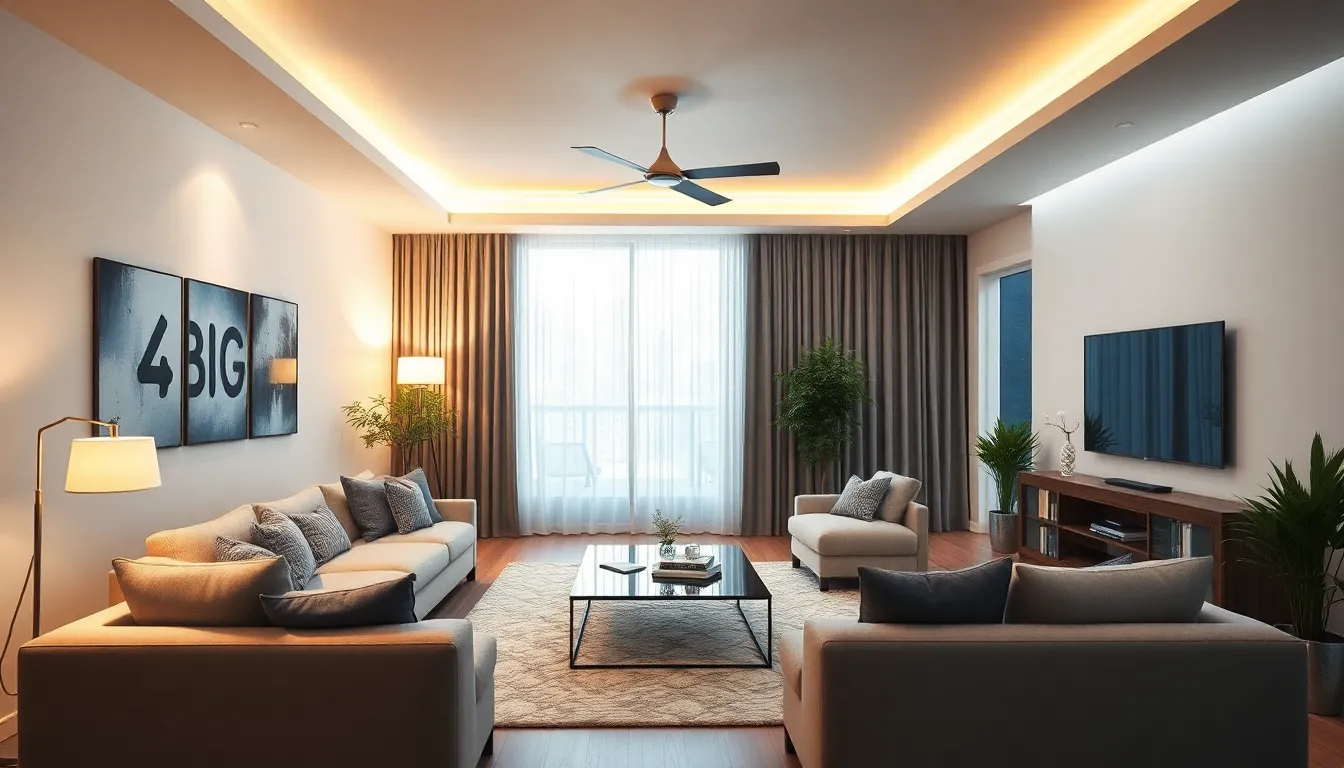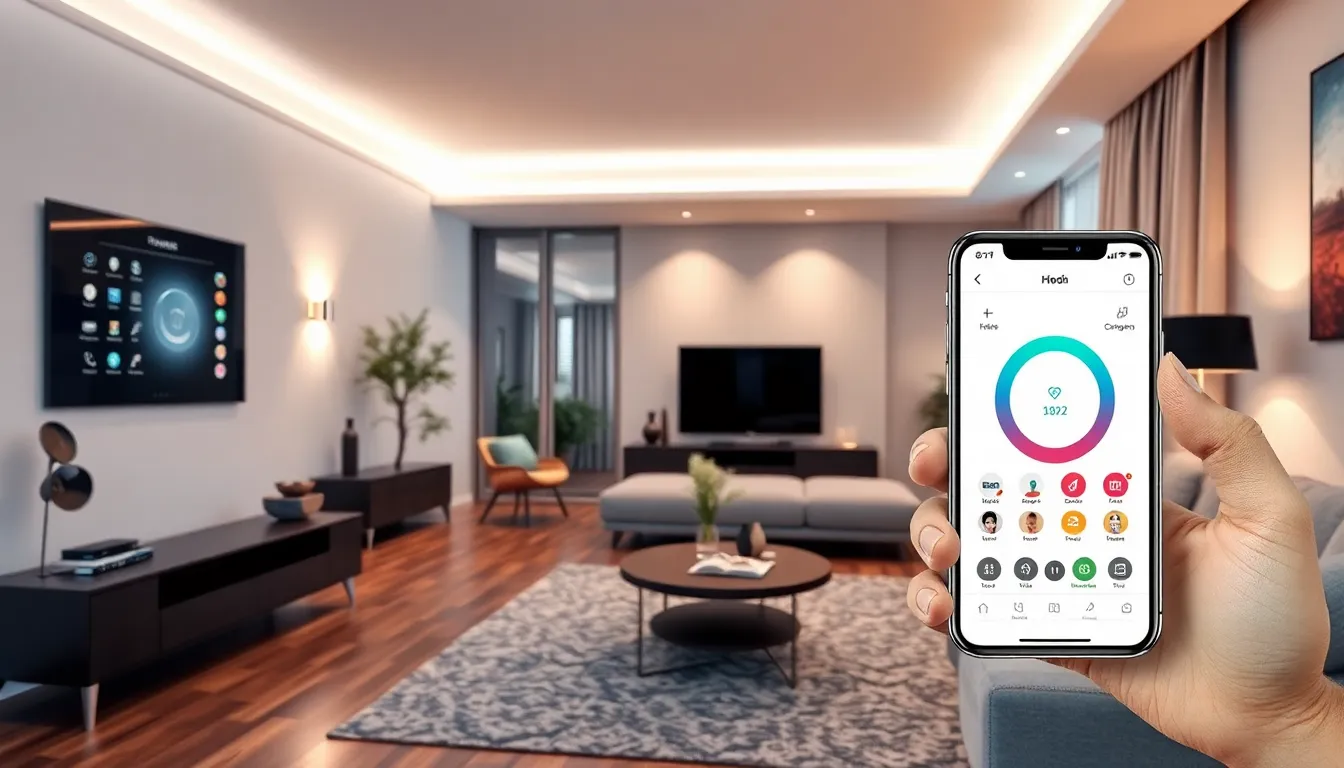Imagine walking into a room where the lights obey your every command—no more fumbling for switches in the dark or squinting at harsh fluorescents. Lighting control systems are the magic wands of modern spaces, transforming the mundane into the spectacular with just a flick of a finger or a simple voice command.
Table of Contents
ToggleOverview of Lighting Control Systems
Lighting control systems provide advanced solutions for managing light in various environments. Users can adjust brightness, color, and timing to create the desired atmosphere. These systems enhance energy efficiency, offering both convenience and sustainability.
Smart lighting technologies integrate seamlessly into existing infrastructure. Users can operate them through apps, remote controls, or voice commands. This versatility simplifies lighting management in homes, offices, and public spaces.
Automation features allow lights to respond to environmental changes. For instance, they can dim during daylight, reducing energy consumption while maintaining comfort. Sensors detect motion and ambient light, ensuring that lights activate only when needed.
Moreover, user-friendly interfaces enhance accessibility. People can create predefined settings for different activities, like reading or entertaining guests. Custom schedules enable lights to turn on or off at specific times, improving security and ease of use.
A variety of systems exist, including wired and wireless options. Wired systems often provide greater reliability, though installation can be complex. Wireless systems simplify setup, utilizing technologies like Zigbee or Wi-Fi for communication.
Energy usage monitoring functionalities track lighting consumption. These insights help users optimize their lighting habits and lower utility costs. Choosing energy-efficient bulbs, such as LEDs, complements these systems and enhances overall savings.
Lighting control systems significantly improve how individuals interact with their environments. They not only promote convenience and customization but also support energy-saving practices, making them an essential feature in modern spaces.
Types of Lighting Control Systems

Lighting control systems fall into two primary categories: wired and wireless. Each type presents unique advantages, catering to different user needs and preferences.
Wired Control Systems
Wired control systems connect directly through physical wiring. These systems tend to offer enhanced reliability and stability, ensuring a consistent connection. Users often appreciate the reduced latency and interference compared to wireless systems. Installation can be more labor-intensive due to the need for electrical work, but it provides a permanent solution once set up. Compatibility with existing infrastructure often exists, allowing easy integration. Wired systems typically support advanced features like dimming and scene settings for customized lighting experiences.
Wireless Control Systems
Wireless control systems operate without physical connections, using radio frequency or Wi-Fi. This design simplifies installation significantly, allowing for flexible placements without extensive wiring. Users find these systems convenient for retrofitting into existing spaces or for use in rentals. Battery-operated devices often accompany them, ensuring easy mobility. Compatibility with smart home devices enhances usability, allowing users to control lighting via apps or voice commands. Flexibility in configuration makes wireless systems appealing for those looking to personalize their lighting without extensive renovations.
Benefits of Lighting Control Systems
Lighting control systems offer several advantages that enhance user experiences in various environments. These benefits include energy efficiency and enhanced comfort, key aspects that define modern living.
Energy Efficiency
Energy efficiency represents a significant advantage of lighting control systems. These systems enable users to adjust brightness and set schedules, leading to reduced energy consumption. For instance, lights can dim automatically in response to daylight, minimizing reliance on artificial lighting. Regular monitoring of energy usage further empowers users to identify patterns and make informed adjustments. Integrating lighting control with energy-efficient bulbs, such as LEDs, amplifies these savings, leading to lower utility bills. Research indicates that homes with smart lighting systems can achieve energy savings of up to 30%. Such efficiency not only benefits individual users but also contributes to global sustainability efforts.
Enhanced Comfort
Enhanced comfort stems from customizable lighting environments created by these systems. Lighting control allows users to set specific moods by adjusting brightness and color temperature. For example, warmer tones can create a cozy atmosphere for relaxation, while cooler tones may enhance focus during work. Predefined scenes cater to various activities, such as movie nights or dinner parties, making transitions seamless. Users benefit from greater accessibility through user-friendly interfaces, whether via mobile apps or voice commands. Additionally, automation features align lighting with user habits, ensuring spaces remain inviting and functional. Overall, lighting control systems significantly improve comfort levels in homes, offices, and public areas.
Key Features to Consider
Lighting control systems offer several essential features that enhance user experience. Consider the following aspects when evaluating different systems.
User Interface
A user-friendly interface ensures easy interaction with the lighting control system. Touchscreens, mobile apps, and voice commands enhance accessibility for diverse users. Intuitive navigation facilitates quick adjustments, allowing users to control lighting settings effortlessly. Responsive design adapts to various devices, ensuring functionality from smartphones to tablets. Customizable options enable users to create presets for specific activities or moods, improving overall comfort in the environment.
Compatibility with Smart Devices
Compatibility with smart devices is crucial for a seamless experience. Many lighting control systems integrate easily with home automation platforms, enabling centralized control of various devices. Users benefit from managing lighting alongside security systems, thermostats, and entertainment systems. Popular ecosystems include Amazon Alexa, Google Assistant, and Apple HomeKit, providing flexibility in how users interact with their lighting setup. Interoperability enhances system functionality and allows for more advanced automation features, creating a cohesive smart home environment.
Future Trends in Lighting Control Systems
Emerging technologies are reshaping the landscape of lighting control systems. Increased integration of artificial intelligence enhances automation, allowing systems to learn user preferences over time. Machine learning algorithms analyze usage patterns, predicting optimal lighting settings according to individual habits and times of day.
Advanced features like voice recognition are on the rise, enabling hands-free adjustments. Users benefit from simply speaking commands to tweak lighting without manual intervention. Moreover, proximity sensors are becoming standard, activating lights as individuals enter or exit spaces.
Sustainability continues to drive innovation in lighting. Energy-efficient LEDs combined with smart controls allow for significant reductions in electricity consumption. Reports indicate that systems leveraging these technologies lead to energy savings of 30% or more, aligning with global sustainability efforts.
Connectivity with the Internet of Things (IoT) expands functionality further. Integration with smart home ecosystems simplifies management of multiple devices from a single platform. Popular systems like Amazon Alexa or Google Assistant are paving the way for seamless control across integrated networks.
User experience remains central to system design. Enhanced mobile applications focus on intuitive interfaces that allow easy navigation for users of all ages. Automation settings, such as scene creation, empower individuals to select preferred atmospheres for various activities with minimal effort.
Finally, privacy considerations are influencing development. As users grow more conscious of data security, manufacturers prioritize encryption and secure data storage in their systems. This addresses potential concerns while fostering greater adoption of smart lighting solutions.
Lighting control systems are transforming the way people experience their environments. By offering convenience and customization they enhance comfort and energy efficiency in homes and workplaces. The integration of smart technology allows for effortless management of lighting through apps and voice commands.
As these systems continue to evolve with advancements in AI and IoT connectivity they promise even greater functionality and ease of use. With a focus on sustainability and user experience lighting control systems are not just a luxury but an essential component of modern living spaces. Embracing these innovations can lead to a more inviting atmosphere while contributing to energy savings and a greener future.







